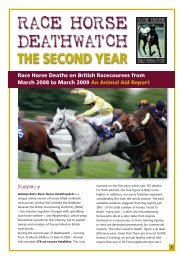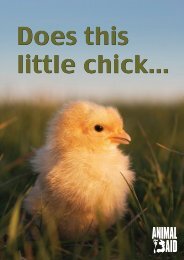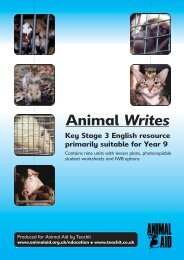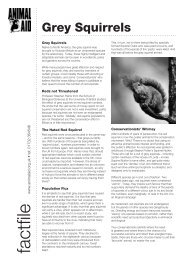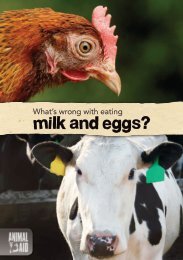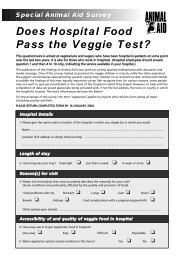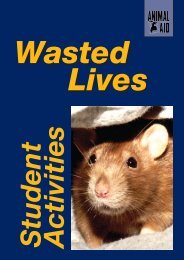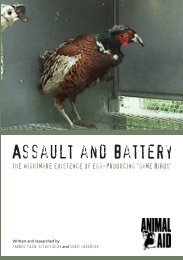Monkeying Around with Human Health: the Cost to ... - Animal Aid
Monkeying Around with Human Health: the Cost to ... - Animal Aid
Monkeying Around with Human Health: the Cost to ... - Animal Aid
- No tags were found...
Create successful ePaper yourself
Turn your PDF publications into a flip-book with our unique Google optimized e-Paper software.
<strong>Monkeying</strong> <strong>Around</strong>With <strong>Human</strong> <strong>Health</strong><strong>the</strong> cost <strong>to</strong> people of experiments on primates'It is time <strong>the</strong>public knewthat usingmonkeys isarchaic anddangerous <strong>to</strong>human health.Theabandonmen<strong>to</strong>f animalmodels isabsolutely vitalfor medicine <strong>to</strong>advance.’Ray Greek MD,MedicalDirec<strong>to</strong>r ofEuropeans ForMedicalAdvancement© Iain Green
Contents© The Israeli Society for <strong>the</strong> Abolition of VivisectionIntroduction 4Poll shows public rejects primate experiments 5Drug testing 6Infectious disease research 11Brain research 12Neurological disorders 15Vic<strong>to</strong>ry over Cambridge Primate Centre 17Second legal challenge <strong>to</strong> Cambridge 22Oxford University undeterred 23Biohazard 24What you can do 25References 27Written by Ray Greek MD and Kathy Archibald BSc,<strong>with</strong> additional information provided by <strong>Animal</strong> <strong>Aid</strong>First published by <strong>Animal</strong> <strong>Aid</strong>, May 2003Revised edition June 2004ISBN: 0-9508990-9-7'I have yet <strong>to</strong> hear a sufficiently compelling scientific argument thatjustifies <strong>the</strong> suffering inflicted on primates in medical research.'- Dr. Charlotte Uhlenbroek, leading prima<strong>to</strong>logist and BBC science presenter.<strong>Animal</strong> <strong>Aid</strong> The Old Chapel, Bradford Street, Tonbridge, Kent TN9 1AW.Tel: 01732 364546 • info@animalaid.org.uk • www.animalaid.org.uk<strong>Monkeying</strong> <strong>Around</strong> With <strong>Human</strong> <strong>Health</strong> 3
IntroductionIn 2002, 3977 experiments using 3173 monkeys were conducted in <strong>the</strong> UK alone. 1The majority were subjected <strong>to</strong> product ‘safety testing’ carried out by pharmaceuticalcompanies or <strong>the</strong>ir contract research organisations. The remainder were used inexperiments <strong>to</strong> study <strong>the</strong> brain, disorders such as Alzheimer’s and Parkinson’s and o<strong>the</strong>rphysiological functions.In an attempt <strong>to</strong> explore how <strong>the</strong> human brain works and develop potential remedies for arange of neurological conditions, monkeys have <strong>the</strong>ir skulls opened and <strong>the</strong>ir brainsdamaged <strong>with</strong> <strong>to</strong>xic chemicals and through surgery. They are <strong>the</strong>n often set a battery oftests in experiments that can last months, and even years. Most experiments end <strong>with</strong> <strong>the</strong>monkeys being killed and various body parts analysed. But prior <strong>to</strong> death, according <strong>to</strong><strong>the</strong> researchers’ own published papers, <strong>the</strong> animals suffer symp<strong>to</strong>ms that include seizures,vomiting, diarrhoea, tremors and uncontrollable body movements.The public is strongly opposed <strong>to</strong> <strong>the</strong> use of primates in labora<strong>to</strong>ries (see box opposite) fora number of compelling reasons that cannot be dismissed as mere sentimentality. Manydispute <strong>the</strong> claim that research on primates is necessary for medical progress and believethat <strong>the</strong> reverse is true. As <strong>the</strong>following pages will show, primates area poor model for such research and<strong>the</strong>ir use has resulted in harm <strong>to</strong>patients, which is an inevitableconsequence of reliance on o<strong>the</strong>rspecies <strong>to</strong> study human diseases.Our close kinship <strong>with</strong> primates isundeniable and <strong>the</strong> more we learnabout <strong>the</strong>m, <strong>the</strong> more it becomesapparent that <strong>the</strong>y share <strong>with</strong> usemotions, intelligence and complexsocial relationships. They are clearlycapable of suffering psychologically aswell as physically when separated from<strong>the</strong>ir family groups, confined in a cage,denied freedom <strong>to</strong> express <strong>the</strong>ir naturalbehaviour and subjected <strong>to</strong> painful andinvasive procedures. All <strong>the</strong>se fatesawait primates used in labora<strong>to</strong>ryexperiments.© Iain Green4<strong>Monkeying</strong> <strong>Around</strong> With <strong>Human</strong> <strong>Health</strong>
The public says ‘No!’A NOP poll commissioned by <strong>Animal</strong> <strong>Aid</strong> in April 2003 found that 52% ofrespondents regarded experiments on primates as morally unacceptable. Only40% said <strong>the</strong>y were acceptable – <strong>the</strong> remainder fell in<strong>to</strong> <strong>the</strong> ‘don’t know’category. When asked whe<strong>the</strong>r <strong>the</strong>y believed that results from primateexperiments could be reliably applied <strong>to</strong> people, 43% said <strong>the</strong>y could not, whilst44% said <strong>the</strong>y could. Amongst <strong>the</strong> younger age groups, a clear majorityregarded such tests as scientifically unreliable.This government came <strong>to</strong> power promising <strong>to</strong> reduce animal experimentation. Yet since2000, <strong>the</strong> British Union for <strong>the</strong> Abolition of Vivisection (BUAV) has revealed, <strong>the</strong>y havebeen secretly planning a new macaque breeding centre - <strong>to</strong> be funded by <strong>the</strong> taxpayer -at <strong>the</strong> military research centre at Por<strong>to</strong>n Down in Wiltshire. 2 This will inevitably increase<strong>the</strong> use of macaques in British labora<strong>to</strong>ries by avoiding <strong>the</strong> current difficulty and delay inprocuring monkeys from abroad.The government also gave <strong>the</strong> go-ahead for Cambridge University <strong>to</strong> build a massive newprimate research centre, which would have housed hundreds of monkeys for use in brainexperiments. This was despite <strong>the</strong> fact that, at a public inquiry ordered by John Prescott,and at which <strong>Animal</strong> <strong>Aid</strong> gave detailed scientific evidence demonstrating that <strong>the</strong> Centrewould produce no benefits for human medicine, <strong>the</strong> presiding Inspec<strong>to</strong>r concluded that <strong>the</strong>University had failed <strong>to</strong> prove its central claim that <strong>the</strong>re was a ‘national need’ for <strong>the</strong>labora<strong>to</strong>ry. Shortly after receiving planning permission, <strong>the</strong> university announced it waspulling out of <strong>the</strong> project for ‘financial reasons’.In 2002, MEPs voted in favour of a complete review of <strong>the</strong> use of all primates inexperiments. They singled out Britain and Cambridge University, in particular, forinadequate enforcement of existing regulations. The next development will be <strong>the</strong>publication of <strong>the</strong> European Commission’s long-awaited proposal for a revision ofDirective 86/609 (which determines how member states of <strong>the</strong> EU regulate <strong>the</strong> use ofanimals in experiments), which will present MEPs <strong>with</strong> <strong>the</strong> opportunity <strong>to</strong> vote for anoutright ban. In 2003, an Early Day Motion calling for a complete ban on all primateexperiments, on <strong>the</strong> grounds that <strong>the</strong>y were scientifically insupportable as well as causingextreme suffering, was signed by no fewer than 131 MPs.The following pages will assess <strong>the</strong> three main types of primate experimentation, on <strong>the</strong>basis of <strong>the</strong>ir scientific value - a key fac<strong>to</strong>r in any attempt <strong>to</strong> justify such a controversialand distressing practice. The three main research categories are drug testing; brainfunction and disorders; and <strong>the</strong> study of infectious diseases.<strong>Monkeying</strong> <strong>Around</strong> With <strong>Human</strong> <strong>Health</strong> 5
Drug testingUsing primates damages and kills peoplePrimates have failed researchers <strong>with</strong> regard <strong>to</strong> <strong>the</strong>ir ability <strong>to</strong> predict dangerous sideeffects of medications. For example:● Hormone replacement <strong>the</strong>rapy - given <strong>to</strong> millions of women following research inmonkeys - has recently been found <strong>to</strong> increase <strong>the</strong>ir risk of heart disease, stroke andbreast cancer. 3● Isoprenaline doses (for asthma) were worked out on animals, but proved <strong>to</strong>o high forhumans. Thousands of people died as a result. In subsequent tests, even when <strong>the</strong>researchers knew what <strong>to</strong> look for, <strong>the</strong>y were unable <strong>to</strong> reproduce this effect inmonkeys. 4● Carbenoxalone (a gastric ulcer treatment) caused people <strong>to</strong> retain water <strong>to</strong> <strong>the</strong> point ofheart failure. Scientists retrospectively tested it on monkeys, but could not reproduce thiseffect. 5● Flosint (an arthritis drug) was tested on monkeys - <strong>the</strong>y <strong>to</strong>lerated <strong>the</strong> medication well.In humans, however, it caused deaths. 6● Amrinone (for heart failure) was tested on numerous nonhuman primates and released<strong>with</strong> confidence. People haemorrhaged, as <strong>the</strong> drug prevented normal blood clotting. Thisside effect occurred in a startling 20% of patients taking <strong>the</strong> medication on a long-termbasis. 7● Arthritis drug Opren is known <strong>to</strong> have killed 61 people. Over 3,500 cases of severereactions have been documented. Opren was tested on monkeys <strong>with</strong>out problems. 8● Aspirin causes birth defects in monkeys but not in humans. 9'It is <strong>the</strong> actual results of tera<strong>to</strong>genicity [birth defect] testing in primates which have beenmost disappointing. Of <strong>the</strong> 15 listed putative human tera<strong>to</strong>gens tested in non-humanprimates, only eight were also tera<strong>to</strong>genic in one or more of <strong>the</strong> various species…'- Dr. JL Schardein, author of 'Chemically Induced Birth Defects'.Despite <strong>the</strong>se failures, marmosets, in particular, are increasingly popular as <strong>the</strong> 'secondspecies' – in addition <strong>to</strong> rodents - required by regula<strong>to</strong>rs responsible for licensingnew drugs. They are attractive <strong>to</strong> pharmaceutical companies because <strong>the</strong>y are small andeasy <strong>to</strong> breed in captivity. Their size makes <strong>the</strong>m cheaper than dogs <strong>to</strong> dose<strong>with</strong> expensive test compounds and easy <strong>to</strong> house in small cages and inhalationchambers.These benefits are itemised in a paper published by <strong>the</strong> Association of <strong>the</strong> BritishPharmaceutical Industry in 2001. 10 The paper notes, however, that marmosets are very6 <strong>Monkeying</strong> <strong>Around</strong> With <strong>Human</strong> <strong>Health</strong>
© Folly Wildlife Rescueexcitable and can be difficult <strong>to</strong> handle. Their small size (and <strong>the</strong>refore blood volume) canbe a problem when multiple blood samples are required. Skilled and experiencedtechnicians are needed <strong>to</strong> dose marmosets intravenously, <strong>to</strong> take blood from <strong>the</strong>ir femoral(thigh) artery, or <strong>to</strong> dose <strong>the</strong>m by 'gavage' - a long tube pushed down <strong>the</strong> throat <strong>to</strong> <strong>the</strong>s<strong>to</strong>mach. Marmosets cannot be trained <strong>to</strong> <strong>to</strong>lerate <strong>the</strong>se procedures and must be restrainedand even sedated.S<strong>to</strong>len from <strong>the</strong> wildNot only do monkeys endure <strong>the</strong> trials of labora<strong>to</strong>ry life, many are imported from suchdistant countries as Mauritius, Israel, Indonesia, <strong>the</strong> Philippines and China. 53% ofprocedures in 2001 involved animals imported from such sources outside <strong>the</strong> EU.Investigations by <strong>the</strong> British Union for <strong>the</strong> Abolition of Vivisection (Paradise Lost,available at www.buav.org) and by <strong>the</strong> RSPCA (Counting <strong>the</strong> <strong>Cost</strong>: available atwww.rspca.org.uk) reveal appalling conditions at some breeding centres, which are oftenfounded, re-s<strong>to</strong>cked and augmented <strong>with</strong> animals trapped from <strong>the</strong> wild. Capture from <strong>the</strong>wild causes huge distress. The first-generation offspring are sold <strong>to</strong> UK labora<strong>to</strong>ries,having been taken from <strong>the</strong>ir mo<strong>the</strong>rs as young as six months old. Their journeys <strong>to</strong> <strong>the</strong> UKare in tiny, cramped crates and can last as long as three days - some monkeys have diedin transit.<strong>Monkeying</strong> <strong>Around</strong> With <strong>Human</strong> <strong>Health</strong> 7
Species under threatConcern about <strong>the</strong> use of macaques, in particular, is heightened by <strong>the</strong>ir conservationstatus. Long-tailed (also known as crab-eating or cynomolgus) macaques and rhesusmacaques are <strong>the</strong> most commonly used species. They are 'old world' monkeys, native <strong>to</strong>Asia, where <strong>the</strong>y live in large social troops that sometimes number 100 individuals. Theyare very communicative and maintain close relationships through mutual grooming. Thelong-tailed macaque is listed as near-threatened on <strong>the</strong> 2000 International Union for <strong>the</strong>Conservation of Nature ‘red list’. The Japanese macaque is listed as endangered; yet up<strong>to</strong> 2,000 are captured and sold <strong>to</strong> Japanese labora<strong>to</strong>ries every year. China is <strong>the</strong> mainsource of rhesus monkeys for Britain but housing conditions <strong>the</strong>re are particularlyhorrifying. Breeding s<strong>to</strong>ck is taken from wild populations, which are in serious decline.'Drawing from <strong>the</strong> wild poses an additional threat <strong>to</strong> <strong>the</strong> conservation status and,ultimately, survival, of some species and local populations.’ Counting <strong>the</strong> <strong>Cost</strong>, report by<strong>the</strong> RSPCA (See p 7.)Monkey data is rubber-stampedUK law states that <strong>the</strong> use of primates is permissible only if <strong>the</strong> researchers candemonstrate that no 'lower' species could be used instead. Yet regula<strong>to</strong>rs (<strong>the</strong> Medical<strong>Health</strong>care Products Regula<strong>to</strong>ry Authority in <strong>the</strong> UK) accept marmoset <strong>to</strong>xicity data <strong>with</strong>outquery. This fur<strong>the</strong>r encourages <strong>the</strong>ir use purely in order <strong>to</strong> gain easy official approval.© Iain Green8 <strong>Monkeying</strong> <strong>Around</strong> With <strong>Human</strong> <strong>Health</strong>
A fundamental point is that <strong>the</strong> use of primates – or indeed any animal species – formedical research has never been properly scientifically evaluated <strong>to</strong> see if <strong>the</strong>ir useproduces benefits for human medicine. This was confirmed when Portsmouth South MP,Mike Hancock – on March 31 2004 - asked an apparently innocuous parliamentaryquestion of <strong>the</strong> Home Secretary. ‘What recent research’, Hancock wanted <strong>to</strong> know, had hisDepartment ‘commissioned and evaluated on <strong>the</strong> efficacy of animal experiments?’The answer was unequivocal. ‘The Home Office has not commissioned or evaluated anyformal research on <strong>the</strong> efficacy of animal experiments.’ In <strong>the</strong> language of tabloidnewspapers, this admission was a ‘bombshell’. Here was <strong>the</strong> government department incharge of regulating vivisection admitting that it had – nei<strong>the</strong>r recently, nor at any o<strong>the</strong>rtime – bo<strong>the</strong>red <strong>to</strong> assess in a systematic way whe<strong>the</strong>r experimenting on animals producedbeneficial results for people. The starkness of <strong>the</strong> admission was made all <strong>the</strong> more glaringby <strong>the</strong> ‘cut and paste’ paragraphs that followed it in <strong>the</strong> formal written answer <strong>to</strong>Hancock. ‘<strong>Animal</strong> experiments must be judged <strong>to</strong> be potentially efficacious in order <strong>to</strong> belicensed under <strong>the</strong> <strong>Animal</strong>s (Scientific Procedures) Act 1986, which requires that animalsmay only be used in scientific procedures where such use is fully justified, where <strong>the</strong> likelybenefits outweigh <strong>the</strong> costs <strong>to</strong> <strong>the</strong> animals involved, and where <strong>the</strong> procedures are mostlikely <strong>to</strong> produce satisfac<strong>to</strong>ry results.’The startling inconsistency in this answer is hardly difficult <strong>to</strong> detect – <strong>the</strong> Home Office willnever grant permission for animals <strong>to</strong> be experimented upon, it was saying, unless it issure that such experiments produce benefits that outweigh <strong>the</strong> harm done <strong>to</strong> <strong>the</strong> animals.Yet it has never itself bo<strong>the</strong>red <strong>to</strong> develop a formal test – based on its own research oranyone else’s - by which it can make such a judgement'Most of <strong>the</strong> animal tests we accept have never been validated. They evolved over <strong>the</strong> past20 years and <strong>the</strong> FDA is comfortable <strong>with</strong> <strong>the</strong>m.' - Anita O'Connor, Food and DrugAdministration (USA) 11Better research methodsThere are more reliable methods <strong>to</strong> predict <strong>the</strong> safety and effectiveness of drugs forpeople. These include in vitro (test tube) studies using human cells and tissues, andsophisticated computer simulations designed <strong>to</strong> mimic human metabolism. A ten-yearinternational study proved that human cell culture tests are more accurate and yield moreuseful information about <strong>to</strong>xic mechanisms than traditional animal tests. 12 The Britishcompany Pharmagene uses human tissue exclusively, noting that 'a flood of new data onhuman genetics is making drug research in animals redundant. If you have information onhuman genes, what's <strong>the</strong> point in going back <strong>to</strong> animals?’ 13Screening new drugs in silico (on computer) is now taking <strong>the</strong> place of many animal tests.German biotech company 4SC designs new drugs entirely in silico and can process in one<strong>Monkeying</strong> <strong>Around</strong> With <strong>Human</strong> <strong>Health</strong> 9
day what would take o<strong>the</strong>r biotechs a month. 'The time is fast approaching when what weare doing will be <strong>the</strong> industry norm,' says chief executive, Ulrich Dauer. 'We have <strong>the</strong>accuracy, <strong>the</strong> speed and we don’t waste time <strong>with</strong> drugs that are not going <strong>to</strong> work.' 14The following example illustrates <strong>the</strong> ineffectiveness of assessing drug safety in animalsand <strong>the</strong> impossibility of detecting subtle human responses: Eight out of ten drugs that were<strong>with</strong>drawn from <strong>the</strong> US market between 1998 and 2001 had serious side effects inwomen that had not occurred in men. 15 All of <strong>the</strong>m had, of course, been testedextensively in animals before <strong>the</strong>y were released on<strong>to</strong> <strong>the</strong> market.If men cannot predict <strong>the</strong> effects of drugs for women, how on earth can we expect <strong>to</strong>obtain reliable data from monkeys?© BUAV10 <strong>Monkeying</strong> <strong>Around</strong> With <strong>Human</strong> <strong>Health</strong>
Infectious disease researchFailure of <strong>the</strong> ‘animal model’Investigating diseases that infect humans in any species o<strong>the</strong>r than humans isnonsensical, as pathogens and immune responses <strong>to</strong> <strong>the</strong>m are highly species specific. Forinstance, chimpanzees are essentially immune <strong>to</strong> <strong>the</strong> human AIDS virus, Hepatitis B and Cviruses, <strong>the</strong> malaria parasite and many o<strong>the</strong>r pathogens <strong>to</strong> which humans are susceptible.'Up <strong>to</strong> this very day, all infectious diseases affecting humans are far from havingappropriate animal models and, even in those cases where such infections arepossible, <strong>the</strong> symp<strong>to</strong>ms observed in animals and <strong>the</strong> course of <strong>the</strong> disease are often verydifferent from those encountered in humans.' - Handbook of <strong>Animal</strong> Models of Infection,Academic Press, 1999, p.7The recent anthrax attacks in <strong>the</strong> US mail were initially not taken seriously enoughbecause experiments on monkeys showed <strong>the</strong> bacterium was not fatal until 8-10,000spores are inhaled. When people died from much smaller doses it became apparent thatthis does not apply <strong>to</strong> humans.The same failings apply <strong>to</strong> vaccine development:'…prevention [of polio] was long delayed by <strong>the</strong> erroneous conception of <strong>the</strong> nature of <strong>the</strong>human disease based on misleading experimental models of <strong>the</strong> disease in monkeys.' 16 -Dr. Albert Sabin, MD, inven<strong>to</strong>r of <strong>the</strong> polio vaccineDespite mounting evidence of vaccine research failures in animals, tens of thousands ofprimates and o<strong>the</strong>r animals have been killed in AIDS research over <strong>the</strong> past 20 years. Thisis despite <strong>the</strong> fact that infecting animals, even chimpanzees, <strong>with</strong> HIV does not produce anequivalent disease <strong>to</strong> human AIDS.Chimpanzee AIDS research abandonedThis reality has long been recognised by many in <strong>the</strong> research community and by AIDSactivists, who have campaigned hard against futile vaccine research in monkeys.'What good does it do you <strong>to</strong> test something [a vaccine] in a monkey? You find five or sixyears from now that it works in <strong>the</strong> monkey, and <strong>the</strong>n you test it in humans and yourealise that humans behave <strong>to</strong>tally differently from monkeys, so you've wasted fiveyears.' 17 - Dr. Mark Feinberg, leading AIDS researcherAfter an extensive review of <strong>the</strong> American AIDS research programme, <strong>the</strong> USgovernment concluded that chimpanzees are a deficient ‘model’ for use in AIDS researchand redirected $10 million of funding. Even <strong>the</strong> direc<strong>to</strong>r of <strong>the</strong> Yerkes Primate Centreadmitted that 15 years of AIDS research in chimpanzees had produced little data relevant<strong>to</strong> humans. 18<strong>Monkeying</strong> <strong>Around</strong> With <strong>Human</strong> <strong>Health</strong> 11
Everything we know about HIV and AIDS has been learned from studying people <strong>with</strong> <strong>the</strong>disease - through epidemiology and in vitro research on human blood cells. Usingprimates <strong>to</strong> predict how humans will respond is not simply unproductive, it has resulted inmedical catastrophe. In <strong>the</strong> early1980s, <strong>the</strong> observation that HIV did not affectchimpanzees led scientists <strong>to</strong> assume that <strong>the</strong> virus would be harmless <strong>to</strong> humans <strong>to</strong>o. Theyconsequently advised health authorities <strong>to</strong> allow transfusions <strong>with</strong> contaminated bloodsamples, <strong>the</strong>reby giving rise <strong>to</strong> <strong>the</strong> French blood scandal that claimed thousands ofinnocent victims.False promiseThe first five-year trial of an HIV vaccine, '<strong>Aid</strong>svax', based on success in animals hasrecently been pronounced a failure. 19 The 8,000 high-risk volunteers in <strong>the</strong> trial were notprotected from HIV infection by <strong>the</strong> vaccine. Many thousands of participants have beengiven false expectations which have been cruelly dashed.Far <strong>to</strong>o frequently, animal models have been used <strong>to</strong> develop vaccines that are effective inlabora<strong>to</strong>ry animals but are ineffective, or actually harmful, in humans. AIDS is a terribleillness, and research money and personnel need <strong>to</strong> be directed <strong>to</strong>ward methodologies thatare viable. Using an archaic methodology like animal models <strong>to</strong> combat a 21st centurydisease is more than foolish, it is immoral.Brain researchExercise in futilityExperimenting on monkeys <strong>with</strong> <strong>the</strong> hope of unlocking <strong>the</strong> secrets of <strong>the</strong> human brain is anexercise in futility. The most dramatic difference between humans and any o<strong>the</strong>r species,including <strong>the</strong> great apes, is found in <strong>the</strong> central nervous system. Our brain is four timeslarger than that of a chimpanzee, which is four times larger than that of a macaque. Thehuman brain is enriched <strong>with</strong> specific cell types implicated in communication, language,comprehension and au<strong>to</strong>nomic functions.‘For cortical regions, such as <strong>the</strong> language areas, we cannot use <strong>the</strong> macaque brain evenas a rough guide as it probably lacks comparable regions.' 20 - Francis Crick,co-discoverer of <strong>the</strong> structure of DNAIn addition <strong>to</strong> ana<strong>to</strong>mical differences, <strong>the</strong> pattern of gene expression in our brain isdramatically different from that of <strong>the</strong> chimpanzee. 21 <strong>Human</strong>s are distinguished from allmammals by <strong>the</strong>ir lack of a particular sugar molecule on <strong>the</strong> surface of cells, especially in<strong>the</strong> brain. It is likely that this profoundly affects brain development and function.Biochemical pathways in <strong>the</strong> human brain are unique. 2212 <strong>Monkeying</strong> <strong>Around</strong> With <strong>Human</strong> <strong>Health</strong>
© The Israeli Society for <strong>the</strong> Abolition of Vivisection- isav@isav.org.ilThe image above was taken in July 2001. It shows Malish, a young long-tailedmacaque, who was used in a series of explora<strong>to</strong>ry brain research experimentsfrom 1998 till late 2002 by <strong>the</strong> Hebrew University in Jerusalem. The publishedconclusion from this research - which is typical of primate experiments in labsaround <strong>the</strong> world - was that ‘non-verbal subjects learn <strong>to</strong> categorize abstractimages by <strong>the</strong>ir ordinal number in <strong>the</strong> list’.<strong>Monkeying</strong> <strong>Around</strong> With <strong>Human</strong> <strong>Health</strong> 13
Many of <strong>the</strong> attributes that we most celebrate - such as our ability <strong>to</strong> express ourselves inprose, poetry, song and dance - are uniquely human. We are clearly different, verydifferent, from chimpanzees.Yet at British universities, including Oxford, Cambridge, Manchester and London,monkeys are still used - at taxpayers' expense - as models of human brain function.This is despite <strong>the</strong> fact that human brains can now be studied non-invasively usinghigh-tec scanners. These enable <strong>the</strong> conscious brain <strong>to</strong> be observed while engaged in avariety of cognitive tasks (e.g. talking, singing, reading, writing) of which monkeys are notcapable - and thus could clearly not provide any relevant insight.State-of-<strong>the</strong>-art researchFunctional MRI scanners can moni<strong>to</strong>r <strong>the</strong> brain activity of volunteers undertaking tests ofmemory and o<strong>the</strong>r skills, <strong>to</strong> reveal brain areas that are active during particularactivities. Transcranial magnetic stimulation (TMS) temporarily disrupts brain function,allowing scientists <strong>to</strong> assess <strong>the</strong> impact of ‘switching off’ specific regions <strong>with</strong>outpermanently removing <strong>the</strong>m. The Dr Hadwen Trust for <strong>Human</strong>e Research is funding suchstudies in<strong>to</strong> epilepsy research at Oxford University. There are many o<strong>the</strong>r state-of-<strong>the</strong>-artimaging techniques now available, including PET (positron emission <strong>to</strong>pography), CAT(computer-aided <strong>to</strong>mography), MEG (magne<strong>to</strong>encephalography), EROS (event-relatedoptical signals) and VBM (voxel-based morphometric analysis). These remarkabletechniques are able <strong>to</strong> differentiate such subtleties as musical ability or whe<strong>the</strong>r© The Israeli Society for <strong>the</strong> Abolition of Vivisection14 <strong>Monkeying</strong> <strong>Around</strong> With <strong>Human</strong> <strong>Health</strong>
someone is lying or how hard <strong>the</strong>y are concentrating. Insights that can be gleaned frommonkeys seem absurdly crude by comparison.One recent study of macaque monkeys at Oxford University was aimed at determining <strong>the</strong>role of <strong>the</strong> cerebellum in cognition, by making a series of lesions in <strong>the</strong>ir cerebella. 23 Themonkeys' skulls were opened and 16 separate injections were made of an acid in<strong>to</strong> <strong>the</strong>right hemisphere, followed a week later by fur<strong>the</strong>r open-skull surgery and 16 injectionsin<strong>to</strong> <strong>the</strong> left hemisphere. The animals were <strong>the</strong>n tested, thousands of times, on cognitivetasks <strong>the</strong>y had been trained <strong>to</strong> perform before <strong>the</strong>ir brain damage. Then <strong>the</strong>y were killedand <strong>the</strong>ir brains extracted for analysis. The experiment served only <strong>to</strong> emphasise <strong>the</strong>difference between human and monkey brains, by contradicting similar studies that hadalready been conducted <strong>with</strong> brain-damaged human subjects. Self-evidently, <strong>the</strong> only way<strong>to</strong> investigate human brain function is <strong>to</strong> study <strong>the</strong> human brain. Results from <strong>the</strong> brains ofany o<strong>the</strong>r species are simply misleading.Neurological disordersA destructive wrong turningIncreasingly, marmosets and macaques are being used <strong>to</strong> study neurological diseases suchas stroke, Alzheimer's, Parkinson's and Hunting<strong>to</strong>n's. Monkeys do not suffernaturally from any of <strong>the</strong>se conditions, so researchers destroy parts of <strong>the</strong>ir brain in order<strong>to</strong> generate superficially similar symp<strong>to</strong>ms and <strong>the</strong>n test potential treatments. But <strong>the</strong>re areimportant differences between <strong>the</strong>se naturally-occurring diseases in humans and <strong>the</strong>artificially-induced monkey versions - differences that render <strong>the</strong> monkey data invalid.For example:● Parkinson's disease becomes progressively worse in patients, while <strong>the</strong> chemicallyinducedmarmoset version demonstrates gradual recovery 24● plaques and tangles in <strong>the</strong> brain are <strong>the</strong> hallmark of Alzheimer's disease in humansbut not in monkeys 25● brain-lesioned marmosets used in <strong>the</strong> study of Hunting<strong>to</strong>n's disease do not replicate <strong>the</strong>pathology or symp<strong>to</strong>ms of Hunting<strong>to</strong>n's disease 26● <strong>the</strong> cause of <strong>the</strong> brain damage is different and one would <strong>the</strong>refore expect <strong>the</strong>treatment <strong>to</strong> be different <strong>to</strong>o 24● countless treatments for stroke have been developed in primates and o<strong>the</strong>r animals -yet all of <strong>the</strong>m have failed or even harmed patients in clinical trials. 'Over-reliance uponsuch animal models [for stroke] may impede ra<strong>the</strong>r than advance scientific progress in <strong>the</strong>treatment of this disease' - Professor David Wiebers, Mayo Clinic 27<strong>Monkeying</strong> <strong>Around</strong> With <strong>Human</strong> <strong>Health</strong> 15
People provide <strong>the</strong> answersFuture advances in our understanding and treatment of neurodegenerative diseases willcome from where <strong>the</strong>y always have - human-based observation and ethical clinicalresearch. Everything we know about <strong>the</strong>se diseases has been learned from studyingpatients while <strong>the</strong>y are alive and after <strong>the</strong>y have died – as well as population researchand studies using human tissues cultured from biopsies or from au<strong>to</strong>psy samples.A new brain-imaging probe has allowed <strong>the</strong> visualisation of Alzheimer's plaques in <strong>the</strong>brains of living patients for <strong>the</strong> first time. This will enable earlier diagnosis andaccurate moni<strong>to</strong>ring of <strong>the</strong> effects of treatments. A number of genes implicated in bothAlzheimer's and Parkinson's diseases have been discovered through population analysis.Biochemical pathways have been charted via <strong>the</strong> study of human brain tissue. It is nowpossible <strong>to</strong> keep slices of living brain tissue alive for weeks, allowing researchers <strong>to</strong> study<strong>the</strong> effect of chemicals on entire neural networks, not just individual cells. Tissues fromdifferent parts of <strong>the</strong> brain can be co-cultured on <strong>the</strong> same chip <strong>to</strong> examine <strong>the</strong>communication between <strong>the</strong>m.Population studies have demonstrated links between dementia and high cholesterol diets,as well as <strong>with</strong> smoking, inadequate vitamin B12 and folate intake, and low oestrogenlevels. Valuable discoveries such as <strong>the</strong>se, from human-based research, render <strong>the</strong> study ofartificial approximations of <strong>the</strong> disease in animals redundant.'Alzheimer's, Parkinson's and o<strong>the</strong>r neurodegenerative diseases occur in humans and it isin human tissue that we will find <strong>the</strong> answers <strong>to</strong> <strong>the</strong>se diseases' 28 - Dr. John Xuereb,Direc<strong>to</strong>r of <strong>the</strong> Cambridge Brain Bank Labora<strong>to</strong>ry16 <strong>Monkeying</strong> <strong>Around</strong> With <strong>Human</strong> <strong>Health</strong>
Vic<strong>to</strong>ry over <strong>the</strong> Cambridge PrimateCentre!In January 2004, <strong>the</strong> campaign against primate experiments won a landmark vic<strong>to</strong>rywhen Cambridge University announced it was abandoning plans for a multi-million poundprimate research centre it had hoped <strong>to</strong> build. The University announced its decision justweeks after <strong>the</strong> Deputy Prime Minister granted planning permission for <strong>the</strong> new lab, whichwould have been <strong>the</strong> largest of its kind in Europe.The project had been simmering for many years but had been held up by <strong>the</strong> local districtcouncil’s refusal <strong>to</strong> grant planning permission. The University eventually appealed and apublic inquiry was carried out, presided over by a government inspec<strong>to</strong>r. Evidence wassubmitted by parties both for and against <strong>the</strong> project. <strong>Animal</strong> <strong>Aid</strong> played a central role inbringing <strong>to</strong>ge<strong>the</strong>r a coalition of doc<strong>to</strong>rs, scientists and animal welfare organisations <strong>to</strong>dispute Cambridge’s claims that <strong>the</strong> new centre would be of ‘national importance’ and <strong>to</strong>demonstrate <strong>the</strong> futility of primate experiments.The results of <strong>the</strong> inquiry were staggering: Presiding Planning Inspec<strong>to</strong>r, Stuart Nixon,concluded, in a lengthy report, that Cambridge University had failed <strong>to</strong> show that <strong>the</strong>rewas a 'national need' for <strong>the</strong> labora<strong>to</strong>ry and categorically recommended that <strong>the</strong> projectnot go ahead. The report was as comprehensive a rejection of Cambridge’s case as canbe imagined. It is no exaggeration <strong>to</strong> state that his findings, in <strong>the</strong>mselves, amount <strong>to</strong> anhis<strong>to</strong>ric vic<strong>to</strong>ry for opponents of animal experiments.Amongst some of <strong>the</strong> comments Inspec<strong>to</strong>r Nixon made were:'... On <strong>the</strong> basis of <strong>the</strong> technical input, I could not conclude that need in <strong>the</strong> nationalinterest is demonstrated insofar as this pertains <strong>to</strong> <strong>the</strong> scientific/medical research andprocedures undertaken by <strong>the</strong> University', and 'In fact, if one accepts <strong>the</strong> premise thatwherever possible research should not involve animals, it would be a stronger argument <strong>to</strong>say that it is nationally important <strong>to</strong> keep <strong>to</strong>ge<strong>the</strong>r and service <strong>the</strong> excellent andacknowledged research expertise in Cambridge <strong>to</strong> catch up on alternative forms ofresearch <strong>to</strong> that employing animals.'However, in spite of his conclusions, Deputy Prime Minister, John Prescott, chose <strong>to</strong> ignoreInspec<strong>to</strong>r Nixon’s report and gave <strong>the</strong> labs <strong>the</strong> go-ahead.As outrageous as his decision was, it was not entirely surprising given that both Tony Blairand Science Minister Lord Sainsbury – a man <strong>with</strong> a major financial stake in <strong>the</strong> biotechindustry, and who is also a major donor <strong>to</strong> <strong>the</strong> labour party – had already publiclysupported <strong>the</strong> project.<strong>Monkeying</strong> <strong>Around</strong> With <strong>Human</strong> <strong>Health</strong> 17
<strong>Animal</strong> <strong>Aid</strong> joined <strong>to</strong>ge<strong>the</strong>r<strong>with</strong> <strong>the</strong> National Anti-Vivisection Society (NAVS) <strong>to</strong>challenge in <strong>the</strong> High CourtJohn Prescott’s decision. Withthat hearing pending, <strong>the</strong> newsthat <strong>the</strong> University wasabandoning its plans wasannounced.The University blamed lack offunding for its u-turn. Thereality is that it was besiegedon all sides:● It had already failed at <strong>the</strong>public inquiry <strong>to</strong> prove <strong>the</strong>proposed merits of <strong>the</strong>research <strong>to</strong> be carried out<strong>the</strong>re.● <strong>Animal</strong> <strong>Aid</strong> and <strong>the</strong>National Anti-VivisectionSociety had filed a High Courtchallenge <strong>to</strong> John Prescott’sdecision.© BUAVRead our Cambridge Inquiry evidence<strong>Animal</strong> <strong>Aid</strong>, working alongside local Cambridge campaigners, played <strong>the</strong>leading role in bringing <strong>to</strong>ge<strong>the</strong>r <strong>the</strong> National Anti-Vivisection Society, Uncaged,PETA, Naturewatch and local activists, X-CAPE (Cambridge Against PrimateExperiments), for joint written and oral submissions <strong>to</strong> <strong>the</strong> Cambridge Inquiry.The ‘coalition’s’ scientific witness was Ray Greek MD, Medical Direc<strong>to</strong>r ofEuropeans For Medical Advancement and co-author of two ground-breakingbooks on <strong>the</strong> failings of <strong>the</strong> ‘animal model’ for human medical research. Readhis written evidence at www.animalaid.org.uk/campaign/vivi/proof.htm - plusfur<strong>the</strong>r evidence at www.navs.org.uk/cambridgeenquiry.html). The British Unionfor <strong>the</strong> Abolition of Vivisection made a parallel presentation <strong>to</strong> <strong>the</strong> inquiry,based on <strong>the</strong> findings of its Cutting Edge undercover investigation of primateresearch at Cambridge University itself (see page 21).18 <strong>Monkeying</strong> <strong>Around</strong> With <strong>Human</strong> <strong>Health</strong>
Examples of experiments on monkeys:1. At Cambridge University, 12 marmosets were given ten or more injectionsin<strong>to</strong> <strong>the</strong>ir brains of a seizure-causing chemical. For nine months <strong>the</strong>y were settasks. One involved having one hand immobilised <strong>with</strong> sticking plaster <strong>the</strong>nbeing forced <strong>to</strong> reach for food 'rewards’. Unsurprisingly, <strong>the</strong> researchers notedthat <strong>the</strong> brain damage caused 'clumsiness'’. In o<strong>the</strong>r tests, researchers bound <strong>the</strong>monkeys’ feet <strong>with</strong> sticky labels and checked how long it <strong>to</strong>ok <strong>the</strong>m <strong>to</strong> bite andtear <strong>the</strong>ir way free. At <strong>the</strong> end of <strong>the</strong> study <strong>the</strong> monkeys were killed. 302. At Oxford University, monkeys were brain-damaged by injection of a <strong>to</strong>xicchemical or by surgical mutilation. To investigate <strong>the</strong>ir reaction <strong>to</strong> stress andfrustration, <strong>the</strong> researchers devised a ‘frustration task’, in which food was visiblebut out of reach. 313. At Guy's, King's and St.Thomas' School of Biomedical Sciences in London,18 marmoset monkeys were nerve and brain-damaged, through daily injectionsa <strong>to</strong>xic chemical, in an attempt <strong>to</strong> mimic certain symp<strong>to</strong>ms of Parkinson'sdisease. The animals suffered a range of dysfunctions, including freezing ofmovements, tremors, loss of control and unstable posture, and <strong>the</strong>y were unable<strong>to</strong> make any sound. 32● In 2003, more than 130 MPs had signed an <strong>Animal</strong> <strong>Aid</strong>-initiated Early Day Motioncalling for all primate experiments <strong>to</strong> be banned – on <strong>the</strong> grounds that <strong>the</strong>y causesuffering and are not medically useful.● The public had registered its opposition <strong>to</strong> monkey research through opinion polls wecommissioned (NOP, April 2003).● There was growing resistance <strong>with</strong>in <strong>the</strong> university itself due <strong>to</strong> <strong>the</strong> controversial natureof <strong>the</strong> project and <strong>the</strong> massive financial burden it would place upon an institution alreadyheavily in debt.Future movesAs things stand, <strong>the</strong> planning permission granted by Prescott is active for five years.Technically, <strong>with</strong>in that time-frame, Cambridge can come forward and announce it has <strong>the</strong>money <strong>to</strong> build <strong>the</strong> new centre after all. Which is why we shall not abandon <strong>the</strong> legalchallenge until we are certain that Cambridge’s monkey centre plans are disposed of forall time. (At <strong>the</strong> time of going <strong>to</strong> press, <strong>the</strong> High Court hearing has yet <strong>to</strong> take place.)Meanwhile, primate experiments continue <strong>to</strong> be carried out <strong>with</strong>in existing departments atCambridge University, and at o<strong>the</strong>r universities across <strong>the</strong> UK.<strong>Monkeying</strong> <strong>Around</strong> With <strong>Human</strong> <strong>Health</strong> 19
Differences are in <strong>the</strong> genesEvolutionary <strong>the</strong>ory explains why we cannot use one animal <strong>to</strong> glean detailedknowledge about ano<strong>the</strong>r. It is <strong>the</strong> different genetic make-up of different species(which ensures <strong>the</strong>ir reproductive isolation; <strong>the</strong> very definition of a species) thatprevents <strong>the</strong>m from being able <strong>to</strong> 'model' one ano<strong>the</strong>r in terms of how <strong>the</strong>y willrespond <strong>to</strong> a disease or a drug. The differences are not between <strong>the</strong> structuralgenes (which build <strong>the</strong> body) - it is true that structural genes are remarkablysimilar across <strong>the</strong> species. Ra<strong>the</strong>r, <strong>the</strong> differences are in <strong>the</strong> way <strong>the</strong> structuralgenes are turned on and off by <strong>the</strong> regula<strong>to</strong>ry genes. It is as though humansand monkeys share a common genetic keyboard on which very different tunesare being played. What matters is not similarity <strong>with</strong> respect <strong>to</strong> <strong>the</strong> keyboardbut differences <strong>with</strong> respect <strong>to</strong> <strong>the</strong> order and timing of <strong>the</strong> pressing of <strong>the</strong> keys.'Each species is a small universe in itself, from its genetic code <strong>to</strong> its ana<strong>to</strong>my,behaviour, life cycle and environmental role, a self-perpetuating system createdduring an almost unimaginably complicated evolutionary his<strong>to</strong>ry.' 29 -Dr. Edward O. Wilson, Emeritus Professor of Comparative Zoology, HarvardUniversityCurrent primate research at CambridgeUniversityCambridge University already conducts monkey brain experiments related <strong>to</strong> <strong>the</strong> study ofstroke, Parkinson's, Hunting<strong>to</strong>n's and o<strong>the</strong>r neurological disorders. <strong>Animal</strong> <strong>Aid</strong> exposedserious flaws in <strong>the</strong>se experiments in its 2001 Mad Science Awards (available atwww.animalaid.org).Additionally, <strong>the</strong> BUAV published a report in May 2002 arising out of a ten-monthundercover investigation of Cambridge University's primate brain research programme(www.buav.org/zerooption/index.html). The report reveals shocking evidence of animalsuffering and a number of breaches of Home Office licence regulations.The cutting edgeMarmosets were subjected <strong>to</strong> major surgery in which <strong>the</strong>ir skulls were sawn open andparts of <strong>the</strong>ir brain sucked out. They were <strong>the</strong>n left unattended overnight, whilesuffering tremors and bleeding head wounds. Incredibly, <strong>the</strong>se experiments wereformally categorised by <strong>the</strong> Home Office – which is charged <strong>with</strong> regulating suchactivities - as leading merely <strong>to</strong> 'moderate' ra<strong>the</strong>r than 'substantial' suffering.20 <strong>Monkeying</strong> <strong>Around</strong> With <strong>Human</strong> <strong>Health</strong>
The BUAV investigationadditionally revealed thatseveral aspects of housing andhusbandry at Cambridgecontravened <strong>the</strong> UniversitiesFor <strong>Animal</strong> Welfareguidelines. Before and aftersurgery <strong>the</strong> monkeys weredeprived of water for 22 hoursper day <strong>to</strong> force <strong>the</strong>m <strong>to</strong>perform <strong>the</strong> tasks for which<strong>the</strong>y were being trained. Foodrestriction was also employedas a motivational <strong>to</strong>ol. Stress isinevitable if animals areunable <strong>to</strong> drink when thirsty orcan see cage-mates being fedwhile <strong>the</strong>y are not. Yet <strong>the</strong> university stated in its Cambridge inquiry evidence that 'it isvital for <strong>the</strong> experiments that <strong>the</strong> animals are stress-free’.© BUAVMost of <strong>the</strong> University’s primate experiments have been performed on marmosets. Butfuture research will focus on macaques, because marmosets' brains, Cambridge hasadmitted, are '<strong>to</strong>o small'.Centre of excellenceThe UK could be a centre of excellence in neuroscience <strong>with</strong>out resorting <strong>to</strong> animal use.The Neurosciences Research Institute at As<strong>to</strong>n University is a prime example of suchforesight, <strong>with</strong> its new ‘Academy of Life Sciences’ scheduled <strong>to</strong> open in 2004. The £8million Academy will provide <strong>the</strong> opportunity for innovative cross-disciplinary work by <strong>the</strong>integration of clinically related research in neuroscience. It will include research groupsworking on behavioural and cognitive sciences, neuro-imaging, vision and ophthalmology- <strong>the</strong> focus being entirely on humans, ra<strong>the</strong>r than animals.World-class research on human brains, both living and post-mortem, such as thatconducted at As<strong>to</strong>n University, <strong>the</strong> Wolfson Brain Imaging Centre and Cambridge BrainBank, is <strong>the</strong> key <strong>to</strong> <strong>the</strong> future of neuroscience. It is time <strong>the</strong> public knew that usingnonhuman primates is archaic and dangerous <strong>to</strong> human health.'The true enemy of excellence is conservatism, an unthinking adherence <strong>to</strong> <strong>the</strong>shibboleths of <strong>the</strong> past' - The Observer, 17 Nov 2002, Vernon Bogdanor, Professor ofGovernment, Oxford University<strong>Monkeying</strong> <strong>Around</strong> With <strong>Human</strong> <strong>Health</strong> 21
Second legal challenge <strong>to</strong> CambridgeFollowing hard on <strong>the</strong> heels of <strong>the</strong> joint <strong>Animal</strong> <strong>Aid</strong>/NAVS High Court challenge, <strong>the</strong>British Union for <strong>the</strong> Abolition of Vivisection (BUAV) launched its own important case inwhich <strong>the</strong> government and Cambridge University are again in <strong>the</strong> dock.Said a BUAV statement: 'We are taking <strong>the</strong> Government <strong>to</strong> court in a Judicial Review,using our shocking undercover investigation of primate brain research at CambridgeUniversity as <strong>the</strong> main evidence. The BUAV believes that <strong>the</strong> Government routinelyunderestimates (and <strong>the</strong>refore misrepresents <strong>to</strong> <strong>the</strong> public) <strong>the</strong> level of sufferingexperienced by animals - particularly primates - used in experiments. The BUAV's undercoverexpose at Cambridge University, as well as many o<strong>the</strong>r BUAV investigations datingback over 14 years, provide ample and damning evidence.The BUAV aims <strong>to</strong> show how <strong>the</strong> Home Office fails <strong>to</strong> take account of many aspects of labanimal suffering when applying what <strong>the</strong> law calls <strong>the</strong> "cost:benefit" test (weighing up <strong>the</strong>cost <strong>to</strong> <strong>the</strong> animal against <strong>the</strong> perceived benefit of performing <strong>the</strong> test). The appallingCambridge experiments (involving monkeys having <strong>the</strong> <strong>to</strong>p of <strong>the</strong>ir skulls sawn off andparts of <strong>the</strong>ir brain sucked out) were categorised by <strong>the</strong> Government as causing only"moderate" suffering. The BUAV intends <strong>to</strong> use its Cambridge investigation evidence <strong>to</strong>challenge this position.'Did primate experiments cause African AIDS catastrophe?On September 11-12th, 2000, <strong>the</strong> Royal Society hosted an extraordinarymeeting, convened <strong>to</strong> examine <strong>the</strong> <strong>the</strong>ory that <strong>the</strong> AIDS epidemic was sparkedby trials of oral polio vaccine (OPV) in Africa in <strong>the</strong> 1950s. The <strong>the</strong>ory claimsthat SIV (simian immunodeficiency virus), an organism naturally carried bychimpanzees <strong>with</strong>out ill effect, was unwittingly passed <strong>to</strong> humans incontaminated polio vaccines which were cultured in ground-up chimpanzeekidneys. Once in its new host, <strong>the</strong> virus mutated in<strong>to</strong> HIV (humanimmunodeficiency virus) <strong>with</strong> devastating effect: 50 million people are nowinfected, most of <strong>the</strong>m in Africa. The evidence which first pointed <strong>to</strong> such anoutcome was <strong>the</strong> striking correlation between <strong>the</strong> earliest African AIDS cases and<strong>the</strong> sites of OPV trials in <strong>the</strong> former Belgian Congo between 1957 and 1960. The<strong>the</strong>ory’s main proponent is former UN official and BBC correspondent, EdwardHooper. Having researched <strong>the</strong> issue for more than 10 years, he sets out his casein The River: a Journey <strong>to</strong> <strong>the</strong> Source of HIV and AIDS (Little Brown, 1999).22 <strong>Monkeying</strong> <strong>Around</strong> With <strong>Human</strong> <strong>Health</strong>
Oxford University UndeterredWith media coverage of <strong>the</strong> Cambridge saga only just dying down, reports of a newfacility under construction at Oxford University started <strong>to</strong> appear.Media coverage reported that <strong>the</strong> new building would only house animals and that noactual research would be carried out. The Guardian quoted a university representative assaying: “The most important point <strong>to</strong> stress is that this is not a research facility, it is forhousing animals…”Unfortunately however, this is far from <strong>the</strong> truth.<strong>Animal</strong> <strong>Aid</strong> has seen <strong>the</strong> planning application and it clearly states that <strong>the</strong> university isapplying for permission for ‘Demolition of existing buildings and construction of researchfacilities’ and for ‘Provision of research labora<strong>to</strong>ries and specialist accommodation <strong>to</strong>support research groups in <strong>the</strong> adjacent Science Area’. The plans state that 31 staff willbe transferring <strong>to</strong> <strong>the</strong> new facility from <strong>the</strong> departments of Experimental Psychology,Zoology, Physiology, <strong>Human</strong> Ana<strong>to</strong>my, Biochemistry and Pharmacology and that a fur<strong>the</strong>r47 new research staff will beaccommodated.A researcher from Oxford also tippedoff campaigners that, for some time,Cambridge and Oxford universitieshad been in discussion over <strong>the</strong>possible transfer <strong>to</strong> Oxford of someprimate research originally plannedfor Cambridge. The fact that <strong>the</strong> newcentre will be linked by a high levelwalkway <strong>to</strong> <strong>the</strong> University’s existingdepartments of ExperimentalPsychology and Zoology - bothknown for conducting primateexperiments – backs up this suspicion.© BUAV<strong>Animal</strong> <strong>Aid</strong> will, once again, takeon <strong>the</strong> challenge of showing OxfordUniversity <strong>the</strong> only way forward is <strong>to</strong>abandon primate research (and allanimal experiments) and focus onhuman-based research instead.<strong>Monkeying</strong> <strong>Around</strong> With <strong>Human</strong> <strong>Health</strong> 23
BiohazardViral threat <strong>to</strong> humansThere is a real and potentially serious risk of an outbreak of human infection resultingfrom primate use and consequent disposal of <strong>the</strong>ir waste products and body parts in<strong>to</strong> <strong>the</strong>drainage and disposal systems. Primates carry a range of diseases that can be harmful,even fatal, <strong>to</strong> humans. The herpes simian B virus, which infects 80-90% of macaques, is aclassic example of a virus that can be dangerous <strong>to</strong> humans once out of its host species inwhom it causes no illness. Twenty-nine people have died from B virus infection, all of <strong>the</strong>mlabora<strong>to</strong>ry researchers or animal handlers.Marburg Disease is named after <strong>the</strong> German <strong>to</strong>wn where <strong>the</strong> first outbreak occurred in1967. Twenty-nine labora<strong>to</strong>ry workers became infected, suffering high fever, slow heartrate, headaches, inflammation of <strong>the</strong> eyes, s<strong>to</strong>mach ache, vomiting, diarrhoea, andprostration. Seven died. They had been exposed <strong>to</strong> tissues or cell cultures from recentlyimportedAfrican green monkeys.In 1989, <strong>the</strong> US authorities in New York State banned all imports of long-tailed,rhesusand African green monkeys when it was suspected that long-tailed macaques suppliedfrom <strong>the</strong> Phillippines were infected <strong>with</strong> <strong>the</strong> lethal Ebola virus. They were actually infected<strong>with</strong> Res<strong>to</strong>n Strain Filovirus, as were two o<strong>the</strong>r macaques in 1996. The Philippinesgovernment temporarily banned <strong>the</strong> export of monkeys while levels of filovirus infectionwere investigated; one facility holding animals infected <strong>with</strong> <strong>the</strong> ‘Res<strong>to</strong>n’ virus wassubsequently closed and hundreds of monkeys were destroyed.Between 1955 and 1963, millions of people were exposed <strong>to</strong> monkey virus SV40 throughcontaminated oral polio vaccines made from monkey kidneys. At <strong>the</strong> time, <strong>the</strong> virus wasthought <strong>to</strong> be harmless. SV40 is now known <strong>to</strong> be associated <strong>with</strong> several human cancers.Never<strong>the</strong>less, monkey tissues are still used in vaccine production.Monkeys undoubtedly harbour innumerable viruses that science has not yet identified.Clearly, it is impossible <strong>to</strong> screen for agents that we don't yet know exist. Who can predictwhat perils we may unwittingly unleash upon ourselves, <strong>with</strong>out even realising our mistakefor years or decades? This is especially <strong>the</strong> case where disease symp<strong>to</strong>ms take time <strong>to</strong>become evident - as <strong>with</strong> AIDS or CJD.Twenty-four monkeys escaped from primate research facilities in <strong>the</strong> US in March 2003alone, illustrating that <strong>to</strong>tal containment, even of <strong>the</strong> live animals, cannot be assured inpractice. Mistakes can and will occur.Following <strong>the</strong> public inquiry in<strong>to</strong> <strong>the</strong> proposed Cambridge primate labs, Inspec<strong>to</strong>r StewartNixon’s report declared:"... it is worth noting <strong>the</strong> Oxford Professor who cites <strong>the</strong> closure of part of a building inOxford University as a direct result of viral escape."24 <strong>Monkeying</strong> <strong>Around</strong> With <strong>Human</strong> <strong>Health</strong>
What you can doExperiments on primates have no future. Science is moving away from outdated studies ofhuman disease in <strong>the</strong> wrong species, <strong>to</strong>wards more productive and clinically relevantmethodologies.There are a number of ways you can support <strong>the</strong> campaign against primate research.Your help is vital. Without public pressure, researchers will continue <strong>to</strong> waste time andmoney on primate experiments, causing enormous suffering and <strong>to</strong> <strong>the</strong> detriment ofhuman health.Get Active!● Send for a free End <strong>Animal</strong> Experiments action pack describing ways you can help usend all animal experiments● Write <strong>to</strong> <strong>the</strong> Vice Chancellor of Cambridge University thanking her for pulling out of<strong>the</strong> monkey lab project. Ask her <strong>to</strong> build on that decision and put Cambridge at <strong>the</strong> forefron<strong>to</strong>f science by implementing a University-wide ban on primate experiments and focuson human-based research instead.Write <strong>to</strong>:Professor Alison RichardVice Chancellor’s Private OfficeThe Old SchoolsTrinity LaneCambridge CB2 1TN● Write <strong>to</strong> Professor Colin Blakemore, Chief Executive of <strong>the</strong> Medical Research Council.Let him know that you do not want primates <strong>to</strong> be imprisoned and <strong>to</strong>rtured for <strong>the</strong>supposed benefit of human health when it is known this type of research does not work.Urge <strong>the</strong> MRC <strong>to</strong> fund non-invasive research projects on human volunteers using state-of<strong>the</strong>-artscanners and o<strong>the</strong>r techniques.Write <strong>to</strong>:Professor Colin BlakemoreChief ExecutiveMedical Research Council20 Park CrescentLondon W1B 1AL<strong>Monkeying</strong> <strong>Around</strong> With <strong>Human</strong> <strong>Health</strong> 25
● Write <strong>to</strong> your MEP and ask him/her <strong>to</strong> vote for a complete ban on primate experimentswhen <strong>the</strong> European commission publishes its long-awaited proposal for a revision ofDirective 86/609 (which determines how member states of <strong>the</strong> EU regulate <strong>the</strong> use ofanimals in experiments). To find out who your MEP is, go <strong>to</strong> www.europarl.org.uk or call020 7227 4300.Write <strong>to</strong> him/her at:European ParliamentRue WiertzBrussels 1047Belgium● Sign <strong>the</strong> BUAV Zero Option petition demanding an end <strong>to</strong> all UK monkey experiments.Go <strong>to</strong> www.buav.org/zerooption/index.html or call <strong>the</strong> BUAV on 020 7700 4888 <strong>to</strong>order hard copies.Please keep letters polite!© BUAV26 <strong>Monkeying</strong> <strong>Around</strong> With <strong>Human</strong> <strong>Health</strong>
References1 Statistics of Scientific Procedures on Living <strong>Animal</strong>s GB 2001, HMSO 20022 Marie Woolf, Independent, 9th December 20023 H D Nelson et al, Journal of <strong>the</strong> American Medical Association (2002) 288: 872-881,Cancer (2003) 97: 14424 S Carson et al, Pharmacologist (1971) 18: 2725 CT Eason et al, Regula<strong>to</strong>ry Toxicology and Pharmacology (1990) 11:288-3076 RD Mann, Modern Drug Use, an Enquiry on His<strong>to</strong>rical Principles, MTP Press 19847 <strong>Human</strong> Toxicology (1987) 6: 4368 CT Eason et al, Regula<strong>to</strong>ry Toxicology and Pharmacology (1990) 11:288-3079 Lancet (1962) 599-60010 D Smith et al, Labora<strong>to</strong>ry <strong>Animal</strong>s (2001) 35: 117-13011 personal communication12 B Ekwall, Toxicology in vitro (1999) 13: 665-67313 New Scientist, ‘Pioneers cut out animal experiments’, 31st August 199614 Leo Lewis, The Independent, 8th September 2002; ‘Will <strong>the</strong> genes map lead <strong>to</strong> a dead end?’15 See report at www.gao.gov/new.items/d01286r.pdf16 Statement before <strong>the</strong> Subcommittee on Hospitals and <strong>Health</strong> Care, Committee on Veterans'Affairs, House of Representatives, USA April 26th 1984 serial no. 98-4817 Atlanta Journal Constitution 21st September 199718 The Scientist (1999) 13 (16): 719 New Scientist (2003) 177 (2385): 7 - see also http://briandeer.com/vaxgen-aidsvax.htm20 F Crick and E Jones, Nature (1993) 361: 109-11021 Science (2002) 296: 233-235 and 340-34322 A Varki, Genome Research (2000) 10: 106523 PD Nixon and RE Passingham, Neuropsychologia (2000) 38: 1054-107224 Medical Research Modernisation Committee, Perspectives on Medical Res. (1991) 3: 35-4625 PH St. George-Hyslop and DA Westaway, Nature (1999) 400: 116-11726 AL Kendall et al, Brain (2000) 123 (7): 1442-145827 Stroke (1990) 21: 1-328 BBC Radio Cambridge, 7th February 200229 Trends in Ecology and Evolution (2003) 18: 77-8030 The influence of exci<strong>to</strong><strong>to</strong>xic basal ganglia lesions on mo<strong>to</strong>r performance in <strong>the</strong> common marmoset,AL Kendall et al; Brain 2000 Vol 123, Part 7, p1442-5831 CE Stern & RE Passingham, Behavioural Berain Research, 1996, Vol. 75, 179-19332 The effects of central aromatic amino acid DOPA decarboxylase inhibition on <strong>the</strong> mo<strong>to</strong>r actions of L-DOPA anddopamine agonists in MPTP-treated primates, SA Treseder et al; British Journal of Pharmacology 2000 Vol 129,Issue 7, p1355-64.<strong>Monkeying</strong> <strong>Around</strong> With <strong>Human</strong> <strong>Health</strong> 27
<strong>Animal</strong> <strong>Aid</strong> exposes and campaignspeacefully against all animal abuse,and promotes a cruelty-free lifestyle.<strong>Animal</strong> <strong>Aid</strong>, The Old Chapel, Bradford Street, Tonbridge, Kent TN9 1AWTel: 01732 364546 • email: info@animalaid.org.uk • website: www.animalaid.org.uk



